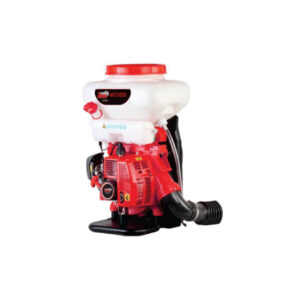Thermal Fogger, Model TS-95
R98,000.00 Excl. VAT
Truck-mounted Thermal Fogger TS-95.
- Description
- Additional information
- Frost protection fog
- Do not use kerosine
Description
This sea freight price requires 8 to 12 weeks to import. The universal High-Performance Thermal Fogger Generator, 50 HP engine power, flow rate up to 100 l/h and effective penetration of the fog in closed spaces. Air cargo is quicker but more costly.
Truck-mounted (pickup truck, bakkie) thermal fogger. Whether stationary in closed spaces or mounted on vehicles for outdoor application, the TS-95 is suit for large scale area quick and effective control.
Truck-mounted Thermal Fogger features a remote control system enable operation from the driver cabin. The unit includes an electric start system for controlling start, stop fogging, lift up and put down fogging tube through the remote control.
Capable of dispense water and oil based chemicals, such as pesticide, fungicide, disinfectant, miticide, poultry vaccine, and odor neutralizer. The unit has been widely used for mosquito carriers of malaria, yellow-fever, dengue fever, pest control, public health protection, sanitation professional.
Additional information
| Weight | 100 kg |
|---|---|
| Dimensions | 230 × 70 × 75 cm |
| Brand | Longray |
| Model Number | TS95 |
| Fuel Tank Capacity | 5L |
| Fuel Consumption | 4L/h |
| Flow Rate | 8-100 L/h (with oil) |
| Tank Capacity | 60L (Solution) |
| Performance of combustion chamber | 36.8 KW / 50 HP |
| Batteries | 12 V lithium battery |
| Chemicals | Both oil and water based chemical solutions |
| Weight (Empty) | 47 kg |
| Pressure in chemical tank | 0.25 bar |
| Pressure in fuel tank | 0.06 bar |
Propylene Glycol Fog Mix for Frost Protection
Standard Mix Ratio
- 20-30% propylene glycol
- 70-80% water
Adjustments for Conditions
- Colder temperatures: Increase propylene glycol up to 40%
- Warmer temperatures: Decrease propylene glycol down to 15%
Mixing Process
- Start with the base ratio of 25% propylene glycol to 75% water
- Mix thoroughly
- Test a small amount in your fogger
- Adjust ratio if needed based on fog density and local conditions
Notes
- Always use food-grade or USP-grade propylene glycol
- Ensure water used is clean and free from contaminants
- Store mixture in a clean, sealed container when not in use
- Remix before each use to ensure consistency
Effective Application of the Fog Mixture:
- Timing:
- Start fogging when temperatures approach freezing (around 34°F or 1°C).
- Continue until temperatures rise above freezing or until sunrise.
- Coverage:
- Ensure even distribution of fog throughout the area.
- Pay extra attention to low-lying areas where cold air settles.
- Wind considerations:
- Ideally, apply when wind speeds are below 2 mph (3.2 km/h).
- If there’s a light breeze, start fogging from the upwind side.
- Height:
- Aim to create a “blanket” of fog above the plants.
- For trees, ensure the fog reaches the canopy.
- Duration:
- Continuous application is often necessary during frost events.
- Have enough mixture prepared for the entire night if needed.
- Equipment maintenance:
- Clean your fogger thoroughly after each use to prevent clogging.
Adjusting the Mix for Specific Conditions:
- Temperature:
- Colder temperatures (below 28°F / -2°C): Increase propylene glycol to 35-40%.
- Milder frost (32-28°F / 0 to -2°C): Standard 25-30% mix is usually sufficient.
- Near freezing (33-34°F / 0.5-1°C): You can reduce to 20-25% propylene glycol.
- Humidity:
- Low humidity: Increase water content slightly to help moisture retention.
- High humidity: Standard mix should work well.
- Crop type:
- Delicate crops (e.g., flowers, young shoots): Use a slightly more diluted mix (20-25% propylene glycol).
- Hardy crops (e.g., mature fruit trees): Standard mix or slightly higher concentration.
- Duration of frost event:
- Short events (2-3 hours): Standard mix is usually sufficient.
- Extended frost periods: Consider a slightly higher concentration to ensure longevity of the protective effect.
- Altitude:
- Higher altitudes: May require a slightly higher concentration due to typically colder temperatures.
- Fogger type:
- Some foggers may perform better with slightly different ratios. Consult your machine’s manual and be prepared to adjust based on its performance.
Remember, these are general guidelines. It’s crucial to monitor the effectiveness of your fog application and be ready to make adjustments. Keep detailed records of the conditions, mix ratios, and results to refine your approach over time.
Would you like more information on any specific aspect of fog application or mix adjustment? Or perhaps you’d be interested in learning about complementary frost protection methods to use alongside fogging?
Risks and Considerations of Kerosene in Frost Protection Fogging
Overview
Some companies market kerosene-based products for frost protection fogging. However, this practice carries significant risks and is generally not recommended by agricultural experts.
Risks
- Plant damage: Direct contact with kerosene can harm plant tissues.
- Soil contamination: Kerosene residues can accumulate in soil, potentially affecting plant health and soil ecosystems.
- Environmental impact: Kerosene is a petroleum product and can have negative effects on local ecosystems.
- Food safety concerns: Residues on edible crops may pose health risks to consumers.
- Fire hazard: Kerosene is flammable, creating potential safety issues during application.
Regulatory issues
- Many jurisdictions restrict or prohibit the use of kerosene for agricultural frost protection due to environmental and health concerns.
- Always check local regulations before considering such products.
Alternatives
- Water-based solutions with food-grade additives (e.g., propylene glycol) are generally safer and often more effective.
- Other frost protection methods like wind machines, sprinklers, or crop covers may be more appropriate depending on the situation.
Conclusion
While kerosene-based products may be marketed for frost protection, the risks generally outweigh potential benefits. Consult with local agricultural extension services or crop specialists for safer, more effective alternatives.















